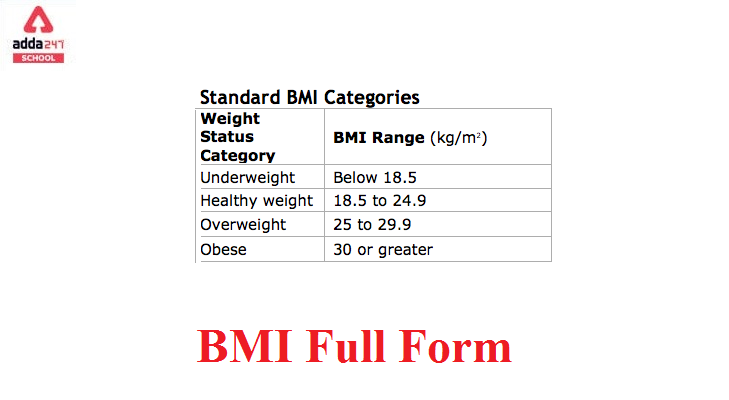BMI Full Form in Medical
What is BMI Full Form? – Body Mass Index is explained here in this article. The full form of BMI, the abbreviation is Body Mass Index. The Body Mass Index (BMI) is calculated from a person’s weight and height. The BMI is calculated by dividing the body mass by the square of the body height and is expressed in kilogrammes per square metre (kg/m2), with mass in kilogrammes and height in metres.
A table or chart that presents BMI as a function of mass and height using contour lines or colours for different BMI categories and may utilise other units of measurement can be used to calculate BMI.
Based on tissue mass and height, the BMI is a handy rule of thumb that can be used to describe a person as underweight, normal weight, overweight, or obese.
Underweight (under 18.5 kg/m2), normal weight (18.5 to 24.9), overweight (25 to 29.9), and obese(30 or more) are the four major adult BMI classifications. When used to predict an individual’s health rather than as a statistical assessment for groups, the BMI has limits that make it less useful than some of the alternatives, especially when used to individuals with abdominal obesity, low stature, or unusually high muscle mass.
BMIs below 20 and above 25 have been linked to an increased risk of all-cause death, with the risk increasing as one moves away from the 20–25 range. The optimal range, however, differs with race.
BMI ka Full Form
बीएमआई का फुल फॉर्म बॉडी मास इंडेक्स होता है। बॉडी मास इंडेक्स (बीएमआई) एक संख्या है जिसकी गणना किसी व्यक्ति के वजन और ऊंचाई से की जाती है। बीएमआई की गणना शरीर के द्रव्यमान को शरीर की ऊंचाई के वर्ग से विभाजित करके की जाती है और इसे किलोग्राम प्रति वर्ग मीटर (किलो / एम 2) में व्यक्त किया जाता है, जिसका द्रव्यमान किलोग्राम में और ऊंचाई मीटर में होती है।
एक तालिका या चार्ट जो बीएमआई को विभिन्न बीएमआई श्रेणियों के लिए समोच्च रेखाओं या रंगों का उपयोग करके द्रव्यमान और ऊंचाई के कार्य के रूप में प्रस्तुत करता है और माप की अन्य इकाइयों का उपयोग बीएमआई की गणना के लिए किया जा सकता है।
ऊतक द्रव्यमान और ऊंचाई के आधार पर, बीएमआई अंगूठे का एक आसान नियम है जिसका उपयोग किसी व्यक्ति को कम वजन, सामान्य वजन, अधिक वजन या मोटापे के रूप में वर्णित करने के लिए किया जा सकता है।
कम वजन (18.5 किग्रा / मी2), सामान्य वजन (18.5 से 24.9), अधिक वजन (25 से 29.9), और मोटे(30 या अधिक) चार प्रमुख वयस्क बीएमआई वर्गीकरण हैं। बीएमआई की सीमाएँ हैं जो इसे कुछ विकल्पों की तुलना में कम उपयोगी बनाती हैं जब समूहों के लिए सांख्यिकीय मूल्यांकन के बजाय किसी व्यक्ति के स्वास्थ्य की भविष्यवाणी करने के लिए उपयोग किया जाता है, खासकर जब पेट के मोटापे, कम कद या असामान्य रूप से उच्च मांसपेशियों वाले व्यक्तियों के लिए उपयोग किया जाता है।
२० से कम और २५ से ऊपर के बीएमआई को सर्व-कारण मृत्यु के बढ़ते जोखिम से जोड़ा गया है, साथ ही जोखिम २०-२५ की सीमा से दूर जाने के साथ बढ़ता जा रहा है। हालाँकि, इष्टतम सीमा दौड़ के साथ भिन्न होती है।
| CBSE Full Form | ICSE Full Form |
| CEO Full Form | SOP Full Form |
| AM PM Full Form | ACP Full Form |









 CBSE Admit Card 2026 for Private & R...
CBSE Admit Card 2026 for Private & R...
 AILET 2026 AIR 1: Check Full Toppers Lis...
AILET 2026 AIR 1: Check Full Toppers Lis...
 AILET Result 2026 OUT, How to Download S...
AILET Result 2026 OUT, How to Download S...














